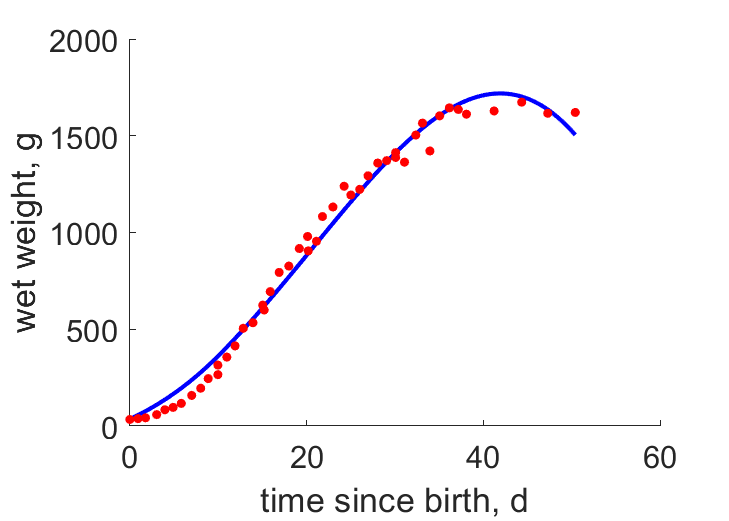Predictions & Data for this entry
| Model: std | climate: MC, ME | migrate: | phylum: |
| COMPLETE = 2.5 | ecozone: MPNW | food: biCvf | class: |
| MRE = 0.026 | habitat: 0xMc | gender: Dg | order: |
| SMSE = 0.001 | embryo: Tnpfm, Tncfm | reprod: O | family: |
Zero-variate data
| Data | Observed | Predicted | (RE) | Unit | Description | Reference |
|---|---|---|---|---|---|---|
| ab | 26.5 | 27.52 | (0.03846) | d | age at birth | avibase |
| tx | 45 | 45.06 | (0.001434) | d | time since birth at fledging | avibase |
| tp | 135 | 142 | (0.05218) | d | time since birth at puberty | guess |
| tR | 511 | 511 | (1.112e-16) | d | time since birth at 1st brood | avibase |
| am | 6497 | 6506 | (0.001368) | d | life span | avibase |
| Ww0 | 42 | 43.26 | (0.03003) | g | intitial wet weight | avibase |
| Wwb | 35 | 34.75 | (0.007112) | g | wet weight at birth | avibase |
| Wwi | 1702 | 1628 | (0.04377) | g | ultimate wet weight for females | avibase |
| Wwim | 2041 | 2037 | (0.001898) | g | ultimate wet weight for males | avibase |
| Ri | 0.01014 | 0.0104 | (0.02582) | #/d | maximum reprod rate | avibase |
Uni- and bivariate data
| Data | Figure | Independent variable | Dependent variable | (RE) | Reference |
|---|---|---|---|---|---|
| tW |  | time since birth | wet weight | (0.0542) | Robe1966 |
Pseudo-data at Tref = 20°C
| Data | Generalised animal | Phalacrocorax pelagicus | Unit | Description |
|---|---|---|---|---|
| v | 0.02 | 0.0315 | cm/d | energy conductance |
| p_M | 18 | 598.7 | J/d.cm^3 | vol-spec som maint |
| k_J | 0.002 | 0.02456 | 1/d | maturity maint rate coefficient |
| k | 0.3 | 0.3004 | - | maintenance ratio |
| kap | 0.8 | 0.9737 | - | allocation fraction to soma |
| kap_G | 0.8 | 0.7999 | - | growth efficiency |
| kap_R | 0.95 | 0.95 | - | reproduction efficiency |
Discussion
- Males are assumed to differ from females by {p_Am} only
- mod_1: Pseudo-data point k is used, rather than k_J; Data set tp and parameter t_R are added, the latter replacing clutch interval t_N. Postnatal T is based on PrinPres1991, see get_T_Aves. See further the revision page, theme puberty
Bibliography